
KiK  |
stylish electronic toy drum kit with fat lo-fi sound |
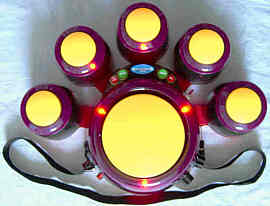 |
 |
Very annoying is that (in unmodified state) this thing roars ear tormenting loud out of its bassy speaker and thus distorts the drums because there is no working master volume control; contradicting the manual, the "VOL" button only switches the volume of the melody tracks (cycles through 3 values) but completely ignores the percussion volume.
Caution: There is a design flaw (missing resistor) that is possibly harmful for the electronics because it overheats the CPU with drumpads held down, which also causes reset problems/ lockups after powering off and on again. Thus always switch the instrument off with the tiny power switch at the case bottom when not in use, to prevent CPU damage by accidentally blocking drumpads.
I guess that this thing was genuinely made in China, but there is no manufacturer marked on the box or instrument, but only the German clothing shopping center "KiK" (where I bought it), which is certainly only an importer. On the box it has the following address:
KIK Textilien und Non-Food GmbH
Siemensstr. 21
59199 Bönen
Germany
Note that the instrument (prototype?) shown on the box has different control panel colours.
 |
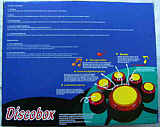 |
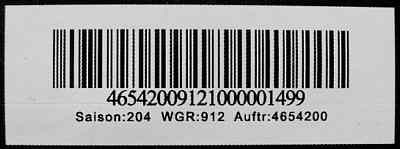 |
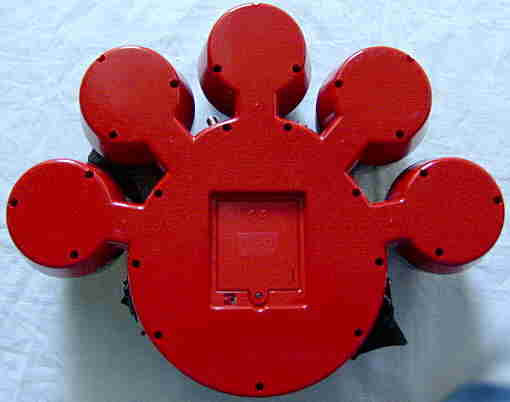 |
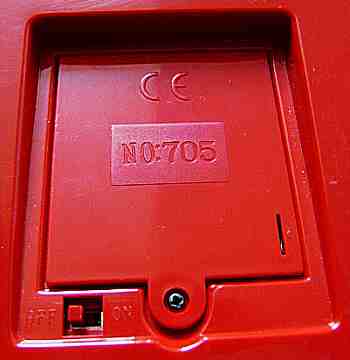 |
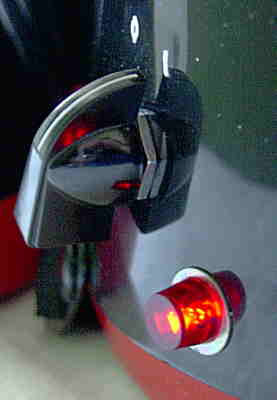 |
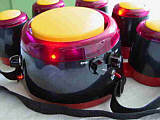 |
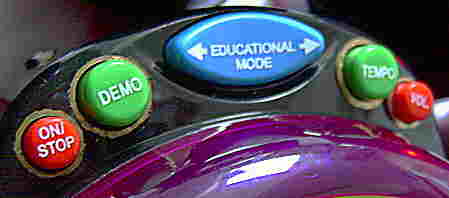 |
 |

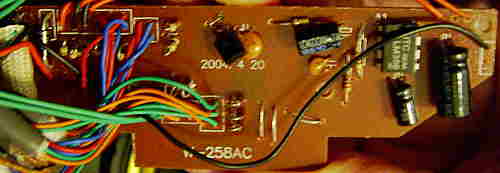 |
The percussion is made from low resolution samples and sounds a bit dull but fairly bassy. While cymbal and hihat sound almost realistic, the toms and base are a little pale and the snare too dull (like with My Music Center percussion). Despite the sound generator is monophonic, it plays nicely since you can hold down any drumpad and drumroll on the big base drum pad (or any drumpad right from the held one), which makes both of them sound alternatingly. In unmodified state every sound stars and ends with an audible popping click, caused by the amplifier power control transistor, which switches on only for the duration of the sound to save batteries. The click gives the sound a trashy appeal but also a lot of pressure. By an easy modification the power control can be disabled to avoid the click, which makes the sound much cleaner (but also more establishment). With my added pitch and volume knob it can make a lot of weird roaring grainy noises now.
The preset rhythm mode is started by pressing the (mislabelled) "tempo" button. Now any drumpad starts a drum pattern of fixed tempo, and any further drumpad presses makes them cycle through the preset rhythms. The order of the rhythms seems to be semi- random and the next selected rhythm seems to depend on the timing with that you press the drumpads, but quickly pressing any pads 5 times always returns to the current rhythm. Instead of the cymbal (leftmost drumpad, which LED lights up) they all play a strange metallic beep tone that resembles a cross between dull car horn and a looped cymbal (possibly it was intended to be a close cymbal).
The 10 demos are all a sort of blues or jazz organ melodies in undistorted
and warm sounding 2 note polyphonic plain squarewave sound, accompanied
by partly complex drum kit solos (also with beep instead of cymbal) using
the given percussion. Also in "educational mode", every melody starts with
a short drum kit intro.
circuit bending detailsThe electronics contains a lot of short cable mess, thus be careful not to damage them when opening the case and removing the PCB. The CPU is a nameless COB (black blob) directly bonded onto the small main PCB. It has a diode in its +Vs line for polarity protection and voltage reduction.fixing the crash & overheat problemThe CPU controls the base pin of a transistor that enables the positive power supply line of the power amplifier IC only while sound is played. Unfortunately there is a severe design flaw in this circuit that makes the CPU run quite warm and often crash during reset and especially crash with increased clock frequency or low battery. The problem is that the CPU is directly connected with the base pin of the transistor without any resistor in between. To fix this, cut the trace at the base pin (between transistor and CPU) and solder a 10 kOhm resistor into it. (It took much time to find this out.)I also have added a 470µF electrolytic cap against GND to the +Vs input of the CPU, which stabilizes its voltage against hum, and additionally as an eye catcher makes the lit LEDs slowly grow dark like glowing electron tubes after power off. click bypass switchTo add a bypass switch for muting the click, solder another 10 kOhm resistor to the base pin and connect it through a switch with GND. (Do not simply bridge the transistor by a switch; the voltage difference at the amp tends to crash the CPU while switching.) Another (possibly now obsolete) measure to reduce crashes is to disconnect the voltage input of the transistor and connect it through a separate 1A silicon diode with the 6V battery output to decouple the amp better from the CPU.volume controlThe sound output of the CPU employs a LC network with a 400 Ohm resistor parallel to a 0.47µF electrolytic cap against GND. Behind it there is an 1nF capacitor in series to an 1 kOhmresistor to the input of the power amplifier IC. The feedback pins of the IC are unused, which makes it roar at maximum volume (and possibly also makes the sound duller). To add a volume control, disconnect the 1 kOhm resistor from the 1nF cap. Connect the open end of the cap with the right end of a new 500 kOhm potentiometer, connect its left end with GND and the wiper with the open end of the 1 kOhm resistor. pitch control & shitshotThe CPU clock frequency is controlled by the 180 kOhm resistor against +Vs of the CPU. To make it adjustable, remove the resistor and connect the clock pin with the wiper of new a 2.5 MOhm potentiometer (smaller value may work also). Connect its left end through a 22 kOhm resistor with GND and the right end through a 100 kOhm trimmer pot (as adjustable resistor) with +Vs of the CPU. Adjust the trimmer in a way that the CPU barely crashes (or not) during demo when the new pitch potentiometer is fully turned right.othersFor the pilot lamp I inserted an orange triangular special LED into the plastic case of a normal red LED pilot lamp and mounted a metal washer behind it, to give it the visual appearance of a mains operated neon lamp known from old flat irons and similar electric heat appliances. But the pilot lamp also serves a practical purpose because the amplifier click bypass switch disables the auto power-off by keeping the amp on power. |
Another strange lo-fi toy drum kit is the Simba
- My Music World drum kit.
| removal of these screws voids warranty... | ||
 |
||
|
|